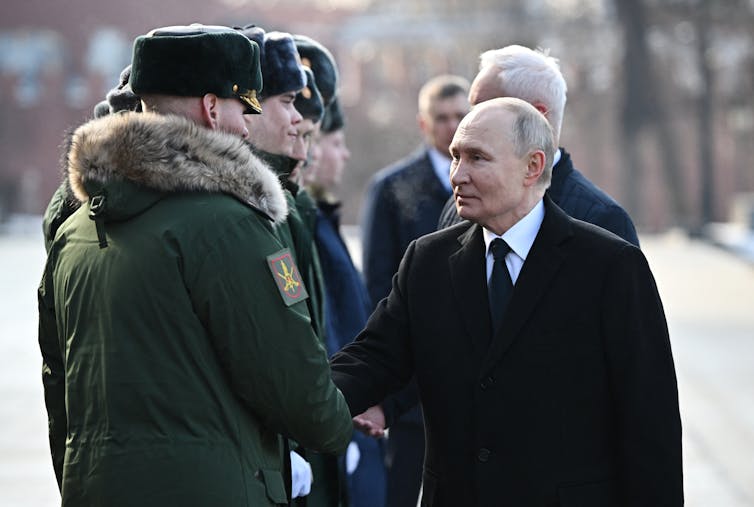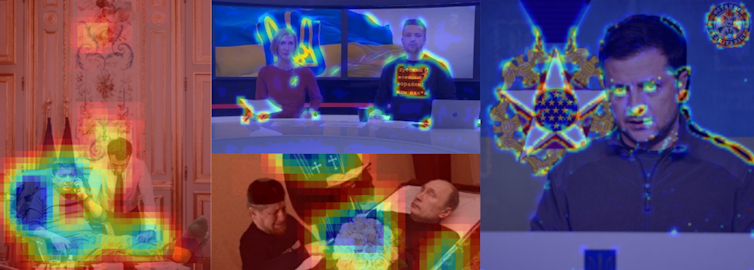
Sergei Bobylyov/AFP via Getty Images
Adam Lenton, Wake Forest University
At face value, the Kremlin has plenty to celebrate after U.S. and Russian officials held high-level bilateral talks on the war in Ukraine for the first time since the full-scale conflict began in 2022.
Russian delegates at the meeting, which took place on Feb. 18 in Saudi Arabia, struck an ebullient tone. Foreign Minister Sergey Lavrov concluded that “the American side has begun to better understand our position,” while Kirill Dmitriev, the head of Russia’s sovereign wealth fund and an envoy for Moscow, noted that the delegates managed to loosen up enough to laugh and joke. President Vladimir Putin did not attend the meeting, but he characterized it the following day as “very friendly,” going as far as to describe the American delegation as “completely different people” who were “ready to negotiate with an open mind and without any judgment over what was done in the past.”
And the talks are far from the only reason for optimism in Moscow. In statements that echoed Kremlin propaganda, U.S. President Donald Trump blamed Ukraine for being invaded and described Ukrainian President Volodymyr Zelenskyy as a “dictator.” The U.S. then sided with Russia in two United Nations votes on the conflict and opposed language describing Russia as the aggressor in a draft G7 statement marking the anniversary of the war.
This perceived rapprochement between Washington and Moscow has many critics on both sides of the Atlantic.
Within Russia the reaction has been mixed. And not everybody in Moscow is celebrating the apparent shift in U.S. policy.
Favoring pragmatism
Of course, many Russians would welcome a thaw in relations. In January, Russia’s leading independent polling group found that 61% of Russians favored peace talks over continuing the war in Ukraine – the highest level yet. Meanwhile, the number of web searches for “When will the ‘Special Military Operation’ end?” on Yandex, a Russian tech firm, reached its highest-ever weekly total in the wake of the U.S.-Russia talks.
While public opinion is unlikely to shape the Kremlin’s approach given Putin’s sole control over major foreign policy decisions, evidence suggests that a rapprochement with the United States could also be a boon for Putin at home.
In a recently published article in the peer-reviewed journal International Security, my co-author Henry Hale and I found that while most Russians view the U.S. and NATO as threats, they largely prefer a pragmatic, measured response from the Kremlin – an approach they believed Putin delivered prior to the war in 2022.
High-level summits between Russia and the U.S. have tended to be well received, we found. This is because they tap into a widely held preference for cooperation as well as depicting Russia as a geopolitical “equal” to the U.S.
Pro-war hardliners speak out
Yet not everyone is pleased with the prospect of closer U.S. ties. Russia’s vocal minority of tub-thumping war supporters is already angry.
This loose community of so-called “Z-patriots” – a reference to the large “Z” letters marking Russian military equipment at the beginning of the war – has been a double-edged sword for the Kremlin.
While they have been helpful in mobilizing grassroots support for the war, they have also lambasted Moscow’s execution and made pointed criticisms of top military brass. Such attacks are, in effect, a way of making veiled attacks on Putin himself.
And we are talking about a sizable minority. Estimates indicate that Z-patriots – the more hawkish and ideologically committed segment of war supporters – represent 13% to 27% of the Russian population.
One of this group’s most prominent ideologues, Zakhar Prilepin, didn’t pull any punches in a recent interview. He described as “humiliating” the fact that “the Russian media community, political scientists and politicians are dancing with joy and telling us how wonderful everything is (now that) Trump has arrived.”
There are reasons to take this group seriously. According to Marlène Laruelle, an expert on nationalism and ideology in Russia, the Z-patriots are emerging as key opinion leaders.
Unlike other ideological camps in Russia, the Z-patriots are very much a product of the war, having emerged from the popular military blogging community and with deep connections to paramilitary and veterans organizations. Indeed, many sympathized with former mercenary Wagner Group chief Yevgeny Prigozhin’s anti-elite rants, while Igor Girkin, a former Donbas warlord who claimed to have sparked the initial war in eastern Ukraine in 2014, openly mocked Putin to his almost million-strong Telegram followers.
The Kremlin partially cracked down on some of the Z-patriots in 2023. Prigozhin’s ill-fated mutiny in June was followed by his suspicious death in a plane crash later that summer, while Girkin was jailed and handed a four-year prison sentence for “inciting extremism.”
Yet the Z-patriots remain a force. Girkin, commenting on the U.S.-Russia talks from prison, lamented the “egregious managerial and command failure” over the past three years and sarcastically concluded that Moscow’s political elites, aware of their own weakness, are likely to “‘drag their heels’ in their inimitable style – and with their well-known genius.”
Other pro-war voices expressed skepticism about the information communicated by the Russian delegation and ironically said they expected the Kremlin would pass a law against “discrediting Russia-American relations,” a play on the March 2022 law against “discrediting” Russia’s military.
Sanctions relief a concern
Some of the sharpest criticisms of the Kremlin have been about the economy.
Recent weeks have seen renewed optimism among many in Russia that sanctions relief is on the horizon and that sought-after Western brands may return. Russia – since 2022 the most sanctioned country in the world – had previously appeared to accept that sanctions would remain for decades to come.
The Russian delegation at the recent talks emphasized the prospect of economic cooperation with the United States, no doubt believing Trump to be receptive to such mercantile framings.
A few days later, Putin announced a willingness to develop Russia’s rare earth minerals with foreign partners, including the United States, in what appeared to be an attempt to outbid Zelenskyy.
This, too, provoked a populist backlash among Z-patriots.
“Grampa’s lost it,” one wrote in a thinly veiled swipe at Putin.
Another displayed dismay that “stealing Russia’s natural resources once again became a prospect for mutually beneficial cooperation with American partners.”
“We’ve barely begun to develop small and medium businesses,” Prilepin noted, deriding the “unbearable” excitement around the possibility of Western brands returning.
These sentiments have struck a chord with other parts of society. After all, some Russian businesses have benefited from Western brands’ exit from the Russian market. The government is attempting to fend off these criticisms with a new bill proposed to Russia’s parliament on Feb. 27 calling to ban Western companies that had financially supported Ukraine.
What to do about veterans?
Perhaps most consequential will be what happens to the hundreds of thousands of Russian soldiers currently on the front lines.
While runaway military spending and lavish payouts to soldiers continue to strain the Russian economy, demobilization also poses risks.
A report from the Institute for the Study of War recently concluded that demobilization would be politically risky for the Kremlin, fearful that masses of disgruntled veterans might constitute a potential challenge.
That said, many of the estimated 700,000 Russian troops in Ukraine will eventually return to civilian life and likely become an important constituency in Russian politics moving forward.
The Z-patriots may be a product of war, but they will have an afterlife beyond it. Meanwhile, regardless of any Russian rapprochement with the White House – or perhaps because of it – Russia’s hawks won’t be turning into doves anytime soon.![]()
Adam Lenton, Assistant Professor of Politics & International Affairs, Wake Forest University
This article is republished from The Conversation under a Creative Commons license. Read the original article.


























































